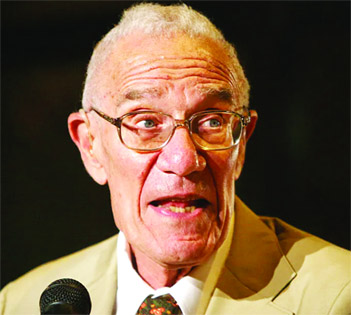Prof D Mukhopadhyay
The realm of economics has been graced by the brilliance of many luminaries, and among them stands Robert Merton Solow, a towering figure in the field of economic growth. Born on August 23, 1924 in Brooklyn, New York, USA Solow’s groundbreaking contributions to the understanding of economic growth earned him the Nobel Prize in Economic Sciences in 1987. His close association with fellow laureate Paul Samuelson(1915-2009), who received the prestigious award in 1970, further enriched the landscape of economic thought. As we bid farewell to Solow, who passed away on December 21, 2023 in Lexington, Massachusetts, USA, this write up seeks to pay tribute to his remarkable legacy and explore the enduring relevance of his work, particularly for a country like India. Rober Solow , an alumni of Harvard University and Columbia University, obtained PhD under the supervision of Wasslily Leontief influenced by John Maynard Keynes, father of Exogenous Growth Model published in 1956 when he was just 32 years old . PhD sudents of Solow include George Akerlof(Nobel Memorial Prize in Economic Sceinces, 2001) Peter Daimond(Nobel Memorial Prize in Economic Sciences, 2010), Joseph Stiglitz(Nobel Memorial Prize in Economic Sciences, 2001), Willium Nordhaus(Nobel Memorial Prize in Economic Sciences, 2018).
Robert Solow’s most enduring contribution lies in his development of the Solow Model, known as Solow-Swan Neoclassical Growth Model, a fundamental framework for understanding the determinants of economic growth which brought him Nobel Memorial Prize in Economic Sciences in 1987. The model, which he introduced in the 1950s, demonstrated that increases in capital and labor alone could not explain sustained economic growth; a significant portion of it was attributable to technological progress. The Solow Model emphasized the role of innovation and technological advancements as crucial drivers of long-term economic growth. This insight revolutionized the way economists and policymakers approached the question of how nations develop and thrive over time. Solow’s model became a cornerstone for subsequent research in growth economics and laid the groundwork for policies aimed at fostering innovation and technological change. Solow’s growth Model is highly relevant to India. India, with her diverse and dynamic economy, stands to benefit substantially from the insights provided by Robert Solow’s work. Several aspects of his model hold particular relevance for India’s economic trajectory such as investment in human capital. India is a highly populated country. Solow’s emphasis on the role of technology underscores the importance of investing in human capital. For a country like India, with a large and youthful population, prioritizing education, skill development, and research and development (R&D) activities is paramount. By cultivating a highly skilled workforce, India can harness the full potential of technological progress, driving sustained economic growth. Technological Innovation is another constituent of growth economics model . India’s economic future is intricately linked to its ability to embrace and generate technological innovation.
Beyond the immediate implications of Solow’s model, it is crucial to acknowledge the profound influence he had on economic thought globally and the potential for his ideas to shape the future of India’s economic landscape. Solow’s work has transcended time and borders, providing a theoretical foundation that resonates with the challenges and opportunities faced by emerging economies like India. Solow’s thought on income disparities and inclusive growth has tremedous potential to work for economic development and growth of India as one of Solow’s noteworthy contributions was recognizing that economic growth alone does not guarantee the elimination of income disparities. India, with her diverse socio-economic landscape, can draw inspiration from Solow’s insights to formulate policies that promote inclusive growth. Focusing on equitable distribution of resources, access to education, and social welfare programs aligns with Solow’s vision of sustainable and socially responsible economic development. Population dynamics as mentioned above is a serious issue and it is one of the key determinants of economic growth. Solow’s model, while emphasizing the positive impact of population growth on economic output, also underscores the need for prudent population policies.
As India grapples with a burgeoning population, Solow’s insights become pertinent in navigating the delicate balance between harnessing the demographic dividend and implementing effective family planning measures to ensure sustainable growth. Comes next is globalization and trade policies and practices. In an increasingly interconnected world, Solow’s model sheds light on the role of globalization in driving economic growth. India, with its commitment to open markets, can leverage international trade to enhance efficiency and access to cutting-edge technologies. By aligning trade policies with Solow’s emphasis on the diffusion of innovation, India can position itself as a key player in the global economic landscape. Solow’s work advocates for a holistic approach to economic policy that considers the interplay of various factors. Policymakers in India can benefit from a nuanced understanding of Solow’s model, integrating it into comprehensive policy frameworks. This involves addressing institutional bottlenecks, fostering a conducive business environment, and ensuring policy coherence to propel the nation towards sustained growth.
Throughout his career, Solow’s analytical rigor and intellectual curiosity left an indelible mark on the economic discipline. His work not only provided theoretical frameworks but also influenced real-world policy decisions and his contribution to growth economics is beacon to the students of economics and researchers. 21st century is the era of technology the role of technology and innovation as drivers of economic progress remains relevant in contemporary economic discourse advocated by Robert Solow. The seminal work of Solow on growth and macroeconomics is a testament to his analytical brilliance and dedication to advancing our understanding of economic systems. His legacy would continue to inspire and guide economists, policymakers, and scholars as they navigate the complex challenges of a dynamic and ever-evolving global economy In reflecting on Robert Solow’s legacy, it is essential to recognize and acknowledge the symbiotic relationship between economic theory and practical application. India, with her dynamic and evolving economy, has the opportunity to not only learn from Solow’s theoretical insights but also to adapt and innovate in the face of contemporary challenges to achieve the desired growth.
(The author is an Educationist and Management Scientist)


